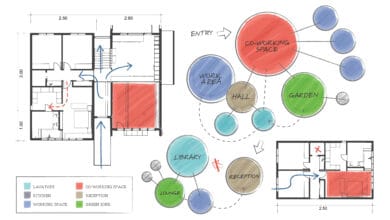What is Drafting in Architecture?

What is drafting in Architecture? It’s the bridge between an architect’s vision and the real world, transforming creative ideas into precise plans that skilled workers use to build everything from towering skyscrapers to cozy homes. Architectural drafting is the essential process that turns concepts into clear, actionable drawings, serving as a vital communication tool for architects, engineers, contractors, and all other construction stakeholders. Curious to learn more about how this process shapes the buildings around us? Let’s dive in.
What is drafting in Architecture?
Architectural drafting involves creating detailed plans and technical drawings that bring an architect’s vision to life. Engineers, contractors, and other professionals use these plans to guide the construction process. It involves transforming rough ideas and sketches into uniform, precise architectural drafts. These drafts include the project’s finer details, such as measurements, foundation plans, plumbing layouts, and electrical wiring diagrams.
Architectural drafting ensures that the construction process accurately reflects the architect’s vision. It is a crucial step required to obtain approval for construction and to comply with local building codes and regulations. Typically done using Computer-Aided Design (CAD) software, drafting requires excellent communication, problem-solving skills, and the ability to collaborate closely with architects and engineers throughout the process.
Why is Architectural Drafting Important?
Architectural drafting is a critical part of the design and construction process. It enables architects and engineers to precisely communicate their ideas and designs through detailed drawings and plans. This ensures that all members of the construction team—clients, contractors, engineers, and workers—understand the full scope of the project.
Drafting also provides technical specifications and exact measurements, allowing the structure to be built precisely according to the architect’s design. Even minor measurement errors can lead to significant issues later on.
Architectural plans are legal documents that must comply with zoning laws, construction standards, and safety guidelines. They guide adherence to building codes and regulations. Additionally, architectural drawings serve as historical records of the design process and the final structure, capturing and preserving the work for future reference.
So, drafting in Architecture is essential for designing, communicating, and constructing buildings that accurately and safely bring an architect’s creative vision to life. Detailed drawings are the key to turning ideas into physical reality.
What’s the difference between Drafting and Architecture?
When considering the differences between drafting and architecture, it is critical to understand what each term means. Drafting primarily involves creating technical drawings or plans for buildings and structures, whereas architecture is a broader field that includes design, planning, and construction. Here’s an overview of the main features and differences:
| Features | Drafting | Architecture |
| Design Principles | Basic principles such as proportion (Architecture), balance & harmony | Advanced design techniques such as form & space |
| Main Tasks | Producing schematic or blueprints designs based on project specifications or requirements. | Planning, and designing, and overseeing building projects from inception to completion. |
| Design Tools Usage | CAD software for technical drawing with detail emphasis | BIM Technology for complex projects with high precision empathy measurements. |
| Education | Associate degree or certificate | Professional degree (typically 5 years) |
| Licensing | Not required in some states but beneficial for career advancement. | Required to legally practice architecture |
Key Skills and Characteristics
- Training and experience in design tools, techniques, and principles to create precise technical plans, blueprints, drawings, and models.
- Knowledge of drafting standards, mathematics, science, and engineering technology.
- Advanced drafting and mechanical drawing skills.
- Expertise in computer-aided design and drafting (CADD) system applications.
- Familiarity with construction documentation principles.
- Well-developed spatial perception.
- Ability to investigate and analyze data.
- Attention to detail and above-average ability to read, comprehend, and apply instructions.
- Artistic and creative orientation.
How to Become an Architectural Draftsperson?
Below is a helpful guide on how to become an architectural draftsperson:
1. Complete a Certificate or Diploma
A certificate or diploma is the minimum requirement for becoming an architectural draftsperson. Various courses are available, such as the Advanced Diploma of Building Design (Architectural) and Certificate IV in Residential Building Drafting. These courses typically take about two years to complete. A diploma or certificate can equip you with the necessary skills and knowledge to create technical drawings, including the fundamentals of computer-aided design (CAD) programs. Proficiency in CAD is often required in many design careers, so becoming skilled in it may increase your job prospects. Completing a diploma or certificate qualifies you to work as an entry-level architectural draftsperson.
2. Consider a Bachelor’s Degree
While a bachelor’s degree is not usually required to become a draftsperson, it can provide you with advanced architectural skills. You can gain these skills through various degrees, such as a Bachelor of Architectural Design or a Bachelor of Design (Architecture). Bachelor’s degrees typically require three years to complete and may take longer than certificates or diplomas, but they often provide opportunities for career advancement. As an architectural draftsperson, advancing your skills through a bachelor’s degree can lead to roles such as architectural designer and open up various other opportunities.
3. Apply for Architectural Drafting Jobs
The experience or qualifications required to become an architectural draftsperson may vary depending on the employer. If you have no experience, you can start with an entry-level job at an architecture firm. Assistant draftsperson positions can help you gain the experience needed to advance to an architectural draftsperson role. Draftspersons typically work for architectural design firms and construction companies, with many opportunities in the residential construction industry. You can apply for architectural draftsperson positions on popular job boards like LinkedIn, Indeed, Glassdoor, or Monster.
Conclusion
Architectural drafting is the backbone of successful projects, ensuring precision, accuracy, and clarity in design documentation. Understanding what is drafting in Architecture involves mastering the fundamentals, complying with industry standards, and using advanced CAD software to empower architects and drafters to increase the quality and efficiency of their work. A deep understanding of drafting techniques and a disciplined workflow are essential for turning visionary concepts into tangible, well-executed structures.



